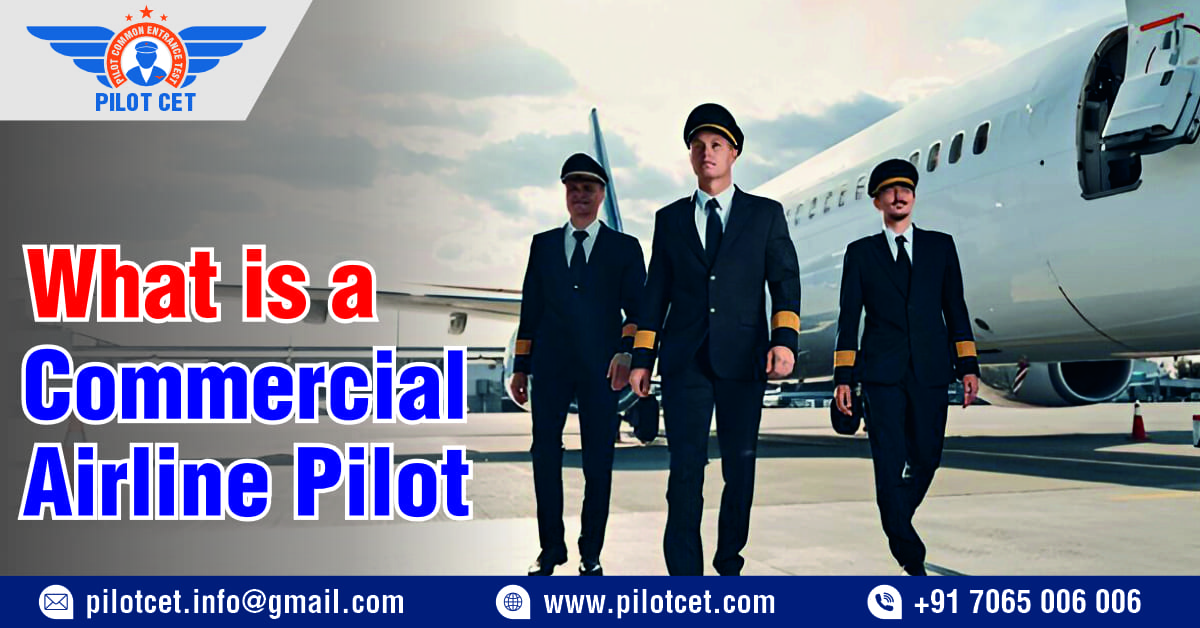
What is a Commercial Airline Pilot?
While finding out flying job prospects in aviation students often ask this question "what is a commercial airline pilot?" so here we are to simplify the answer of this question for you. A commercial airline pilot is a trained professional who specifically flies the passenger or cargo aircrafts for airlines. They play a very important role in international travel through aviation as they ensures the efficient air travel with proper safety around the world.
Their primary responsibilities involve piloting the aircraft, controlling the air flights and navigating during various weather conditions. They even talk with the air traffic control, scan aircraft systems and make prompt decision to prevent accidents to the passengers and crew.
Types of Airline Pilots
Airline pilots can work in different roles based on their experience, route type and aircraft operations. Each type of pilot has specific duties and responsibilities to ensure safe and efficient flights. As explained below:
- Captain: Pilot in command responsible for flight safety and final decisions.
- First Officer (Co-Pilot): Assists the Captain in flying, navigation, and communication.
- Second Officer: Supports on long flights, taking control during cruise.
- Cargo Pilot: Transports goods and materials instead of passengers.
- Charter Pilot: Flies private or on-demand routes for clients or tour groups.
- Corporate Pilot: Operates private jets for businesses or VIP passengers.
- Flight Instructor: Trains new pilots in flying techniques, safety, and aircraft handling.
- Test Pilot: Flies new or modified aircraft to check performance, safety, and design efficiency.
Eligibility Requirements
To become a commercial airline pilot, students need to meet certain requirements which are given below:
|
Requirement |
Details |
|
Age |
17 years to start training, 18 years for CPL. |
|
Education |
10+2 with PCM and equivalent. |
|
Language |
Must be fluent in English. |
|
Medical |
Pass DGCA Class 1 medical test. |
|
CPL |
Needed to work as a pilot; 200 flying hours required. |
|
ATPL |
Needed to become a Captain about 1500 flying hours required. |
Skills Needed
- Communication & Decision-Making: Clear communication and quick decision making is necessary as pilot have to communicate with the ATC and handle the emergency situations.
- Leadership & Teamwork: Pilots leads the crew and working staff so it is essential for him to maintain the teamwork so the journey will complete smoothly.
- Technical Knowledge: He should have great understanding of aircraft systems and navigation etc.
- Emotional Stability: Staying calm under pressure is important in any situation.
- Situational Awareness: Staying focused and monitoring environment and aircraft status to prevent any emergencies.
- Problem-Solving: Pilot must be good at solving problems & handling emergencies efficiently.
- Adaptability: He should be adjusting to changing conditions.
- Attention to Detail: Pilots have to be very attentive & follow the safety protocols.
- Time Management: Managing flights and schedules efficiently.
Work Environment and Schedule
Airline pilots job is very dynamic one as it involves not only flight but also ground work. They follow a routine of thorough planning, collaboration, and intense attention in order to make all flights run safely and efficiently. The table below highlights a pilot's daily tasks, work hours & travel patterns:
|
Aspect |
Details |
|
Typical Day |
Includes pre-flight briefings, weather checks, route planning and aircraft inspection before takeoff. |
|
During Flight |
Pilots control the aircraft, monitor systems and communicate with air traffic control to ensure a safe journey. |
|
Post-Flight Duties |
After landing, they complete flight reports and review aircraft performance for the next flight. |
|
Work Hours |
Pilots work in shifts, including early mornings, nights, weekends and holidays. |
|
Travel Pattern |
Domestic pilots return home more often, while international pilots stay in different cities or countries between flights. |
|
Work Environment |
Involves time in the cockpit, airports and hotels during layovers; requires alertness and responsibility at all times. |
Career Growth & Opportunities
- Start as a First Officer (Co-Pilot): This is where you start your career as a helper to the Captain in controlling the air and communicating.
- Gain Experience: Next step is to gain the flying hours usually several hundred to a few thousand, depending on airline requirements.
- Promotion to Captain: After gaining experience and leadership skills you can be promoted to Captain and take full command of the aircraft.
- Specialized Roles: Experienced pilots can become flight instructors for example examiner pilots or training captains to guide new pilots.
- Career Opportunities: Pilots can work in commercial airlines, cargo airlines, charter services or private and corporate aviation etc.
- Further Growth: With time pilots can move into senior roles such as chief pilot, flight operations manager or aviation consultant etc.
Salary (India & Abroad)
Average monthly salary for CPL holders working in India and abroad varies depending on the country, airline policies, type of aircraft flown and cost of living etc. Countries in Middle East and Asia Pacific are associated with higher pay packages and other benefits like housing and tax exemptions whereas the USA and UK are associated with competitive salaries and career advancement. Below is given a table of average CPL monthly salaries:
|
Job Role |
India (INR) |
USA (INR) |
Canada (INR) |
UK (INR) |
UAE (INR) |
|
First Officer |
4 - 5 Lakh |
10 - 12 Lakh |
8 - 10 Lakh |
7 - 8 Lakh |
12 - 15 Lakh |
|
Flight Instructor |
6 - 7 Lakh |
8 - 10 Lakh |
7 - 9 Lakh |
5 - 7 Lakh |
10 - 12 Lakh |
|
Cargo Pilot |
5 -8 Lakh |
14 - 16 Lakh |
9 - 11 Lakh |
6 - 8 Lakh |
13 - 16 Lakh |
|
Corporate Jet Pilot |
8 - 10 Lakh |
15 - 17 Lakh |
10 - 12 Lakh |
7 - 9 Lakh |
15 - 18 Lakh |
|
Charter Pilot |
5 - 6 Lakh |
9 - 12 Lakh |
8 - 10 Lakh |
6 - 7 Lakh |
11 - 14 Lakh |
|
Air Ambulance Pilot |
5 - 6 Lakh |
10 - 12 Lakh |
9 - 10 Lakh |
6 - 7 Lakh |
12 - 15 Lakh |
|
Government Pilot |
6 - 8 Lakh |
12 - 15 Lakh |
10 - 12 Lakh |
7 - 9 Lakh |
15 - 18 Lakh |
Benefits in the Profession
- Travel Perks: Pilots get free or discounted air travel for them and family members.
- Insurance: They get insurance facilities such as health, accident and life insurance coverage.
- Lifestyle: They visit new countries and explore diverse cultures.
- Accommodation: Pilots get free hotel stays and travel allowances during layovers.
- Flexible Schedule: Off days between flights allow time for rest or travel.
- Retirement Benefits: Many airlines offer strong pension and retirement plans.
- Training Opportunities: Access to continuous skill development and simulator training.
- Global Exposure: Experience working with international crews and modern aircraft.
- Job Prestige: Highly respected and admired profession worldwide
Challenges in the Profession
- Jet Lag: Frequent time zone changes can affect sleep and body rhythm.
- Long Hours: Irregular schedules and extended flight times can be tiring.
- High Responsibility: Pilots must ensure the safety of passengers, crew, and aircraft at all times.
- Stress Management: Requires calm decision-making during emergencies or tough weather conditions.
- Time Away from Home: Extended trips can lead to less family time.
- Health Issues: Continuous travel and changing routines can impact physical fitness.
From the above details we can say that being a commercial airline pilot is a very exciting and rewarding career. Pilot can travel around the world, experience new places and meet different peoples from different cultures. Airline pilot job offers adventure, respect and a strong sense of responsibilities all at once. It is a dream career for many it combines passion with purpose. With dedication and the right training, anyone who loves aviation can turn this dream into reality.

Recent Articles
- What is Commercial Pilot Course?
- PPL (A) Licence
- CPL Holder Meaning
- What are the requirements to become a pilot?
- What is a Commercial Airline Pilot?
- CPL Aviation
- What should I do after 12th to become a pilot?
- What is the eligibility to become a pilot?
- what is a commercial pilot license?
- Pilot Eligibility for Female
Frequently Asked Questions
A commercial airline pilot is a trained professional who flies passenger or cargo aircraft for airlines. They ensure safe and efficient travel by steering the plane navigating through weather conditions and communicating with air traffic control.
read more..
You should consider this career because it offers adventure global exposure travel perks respect and a strong sense of purpose.
read more..
You can begin training after you finish 10+2 with Physics Chemistry and Maths (PCM) and you should be at least 17 years old to start training.
read more..
To work as a pilot you need a Commercial Pilot Licence (CPL) and around 200 flying hours. To become a captain you may need around 1,500 flying hours.
read more..
Yes, it can be challenging irregular hours jet lag from time zone changes long flights and high responsibility. But with the right mindset you can handle it well.
read more..
While flying is the exciting part there s much more pre and post flight checks route planning weather checking system monitoring reports teamwork and continuous learning make this career complete.
read more..
Commercial Pilot License Commercial Helicopter Pilot License Private Pilot License Private Helicopter Pilot License
